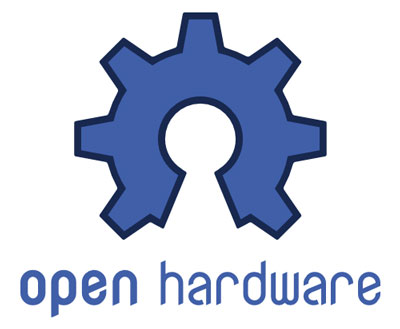Open source software movement had to climb big hurdles to rise to the firm pedestal where it stands today. A notion that had started as early as in 1970s started to gain grounds only towards the culmination of the millennia. The recent spurt in the open source software market and in the open source movement itself makes us ponder on the next logical step. Open Source Hardware? 

Fig. 1: Symbolic Image of Open Source Hardware
Before we focus on the ‘Open Source Hardware’, let us see how Open Source Software works. Open source software is a software for which the source code is available to its users. Depending on the terms of the license, it can be read, modified, enhanced and redistributed under the same license. In software section, it works fine because the marginal costs involved with the distribution of software is effectively nil. While users are not paying for the product, they are stimulating the market from where the revenue may be generated for the developers in the form of service support charges or advertisements. This effectively puts forward open source software as a service based business rather than a product based business.
But hardware is a little different. It involves manufacturing on Silicon, and fabrication is something that not everyone can manage leave alone distributing it at costs that could be termed as marginally zero. Then what makes Open Source Hardware seem like a lucrative business model to many people? The answer lies in the definition of Open Source. It is not quite related to manufacturing and distributing hardware, but the Intellectual Property involved in making it. Any Silicon chip made these days is built from silicon ‘Intellectual Property’ which is written in hardware descriptive languages like Verilog and VHDL. For example, ARM does not itself produce chips on large scales for industry, but it is its processor IP which is built by its licensee companies into the multi-billion number of chips. Further, it is the software and firmware on the chip that need frequent updating. This opens up avenues for Open Source Hardware which offers nil marginal costs, and associated products whose monetary worth is driven by sheer volume. It isn’t about giving away chips for free, but the IP in the form of circuit design diagrams and schematics. The one getting these will still have to make the physical chips and put in the money required for that.
So if Open Source Hardware too is about sharing the ‘intangible soft parts’ of the hardware, then how does it differ from Open Source Software? Though the Silicon Intellectual Property is written in languages like VHDL, the results are not distributed through publication, but through manufacture, unlike software. Manufactured dissemination is generally governed and protected legally by Patents and not by copyrights which protect software. Philosophically, both approaches are identical. In the software domain, when we buy an OSS executable, we also receive a source code of the application. Much in the similar manner, when we buy an open source hardware product, which simply is the executed version of the design, we also receive the source material details in the form of full documentation which can reproduce the same product.
OSH license
There have been efforts in writing a formidable open source license aimed specifically at hardware in the absence of which, the open source hardware projects have to use the GPL and similar licenses which are primarily meant for software. The licenses for hardware have ported the fundamental principles of Open Source Software. A notable attempt at this is the Tucson Amateur Packet Radio (TAPR) Open Hardware License. Some organizations go for shared licenses like Opencores rallying for LGPL, FreeCores for GPL, Open Hardware Foundation voting for “copyleft” etc. It is a licensing agreement for electromechanical parts published under Open Hardware Licenses by the author(s) of the work which shall allow others to use that work for free, without any royalties or licensing fees. It has a certain constraints too, most importantly being the ‘share-alike’ and the ‘attribution requirements’. As mentioned before, an OSS relies on the capabilities of the copyright. But in case of hardware, things are a little tough and hence it has multiple layers available for licensing. These can be:
1. Mechanical Layer: This layer deals with the mechanical description of the project like the enclosure design, materials, units and dimensions, distributed in the form of CAD files (which might be from proprietary vendors like Autocad and Corel Draw). The drawing itself is copyrightable while the content is patentable published in well known formats like PDF, DWG, AI or DXF.
2. Schematic Layer: These are symbolic representations of electronic projects depicting the interconnections between parts. The image is copyrightable, but its content is not. The contents of the image include part lists and numbers and are generally distributed as easily readable graphics formats like BMP, PNG, JPG and PDF.
3. Layout Layer: PCB Layouts, which basically are derived from the schematic itself, further taking into consideration of the various layout requirements like trace widths and lengths, part placements etc. and are employed to create the physical circuit boards. These are distributed as copyrightable vector artwork formats like Gerber/Excellon.
4. Parts Lists and Datasheets: The part lists may be distributed as a part of the schematic (in the form of labeling)or as separate texts along with the datasheets of the components used. These components too should be freely available.
5. FPGA Code: Essentially the ‘software for silicon’, it is the text that defines the chip design. The code is copyrightable.
6. Firmware Code: It is copyrightable software that is burned into the memory to define the particular functions of the microprocessors or microcontrollers.
7. Software: Software that generally sits on top of the firmware for added functionality and is getting very common as embedded computers become commonplace.
The distribution terms of OSHW must comply with the criteria laid down in the license. The hardware release should be accompanied with complete documentation which shall include design files, and allow modifications and distribution of design files, and in case that is not possible, it should be available over well publicized means. It should explicitly show as to what part of the design is being released under the open source hardware license. If in case the hardware uses an embedded code or any software, then the necessary software should either be released under an Open Source Initiative approved open source license or the interfaces should be so documented that it is easy to write open source software for the purpose. The license allows modification of the works and hence, derived works from it along with permission to manufacture sell and distribute the products created from the design files. It shall not stop any party form selling or giving away the documentation and shall not require a royalty or any such fee for the sale. However, the derived documents and copyright notices associated with devices should provide attribution to the licensors and that this information should be accessible to the end-user as well. The license should not discriminate against any individual or group and must not be product specific which restricts hardware or software to a limited licensed works hence showing bias and discrimination. Most of these rules have been adapted or taken as it is from the open source software license.
Future
But things are not that easy in case of Open Source Hardware than its software counterpart. Software can be easily modified to satisfy the whims of the creators, but in case of hardware, the implications of a single minor change can be disastrous for the overall design and even the physical integrity of the design. Taking the case of microprocessors, the hardware gates, signals and pipelines and the rest of the circuitry are intricately woven around each other in a manner no source code can be. Support is something that is only available on very small scale hardware devices. When the complexity goes beyond the expertise of a few men, people would generally bank on proprietary hardware so that in case anything goes wrong, they can claim a warranty support. Also there is an added issue that if everybody starts tweaking the hardware to make it ‘just right’ for them, there might not be software that would run on the customized hardware. Developing a worldwide community isn’t much possible in case of hardware because not everyone has access to a fabrication facility and transporting chips back and forth over courier or postal services is too slow a process in contrast to software codes that can be shared over the internet in a matter of seconds. This discourages most designers to venture out into the dark without existing, well proven designs.
Platforms like Arduino have taken the Do-it-yourself fervor from the software to the hardware part among hobbyists and designers. All the designs are available on their website for download and are not patented. This has been a hit so far. Many companies have joined the Open Source Hardware brigade like the BugLabs with their modular open source designs for mobile devices and Makerbot. The scenario has opened up in a very short time which is indeed a good sign. By 2005, there were only a handful of open source hardware projects, but as of 2011 more than 200 projects have been launched under the OSHW banner. A chip company called VIA released an open source laptop in the recent past. There’s an open source phone called OpenMoko which when combined with the Google Android OS forms a completely open source product. There have been open source mp3 players, routers, music visualisers and many more electronic gadgets apart from the robotic projects.
Open Source hardware is a way of accelerating innovation. Communities like ROS, Willow Garage, OpenWetware, Pearl Biotech, Pranav Mistry’s Sixth Sense and many more are giving a new outlook to the ways we can deal with intellectual property. It shows a lucrative alternative to developing and then locking away the product design by patenting or copyrighting it. Just when the patented products need to be publicized by the developer to potential vendors, a popular open source hardware product might just bring vendors to our doorsteps looking for design consultancy. The road ahead might be an uphill task, but isn’t impossible. Even the Open Source software had shaky and uncertain beginnings. But today, even big firms of the likes of Google are using open source software (linux) to support their vast infrastructures. This could be the next reality for open source hardware too!
Filed Under: Articles


Questions related to this article?
👉Ask and discuss on EDAboard.com and Electro-Tech-Online.com forums.
Tell Us What You Think!!
You must be logged in to post a comment.